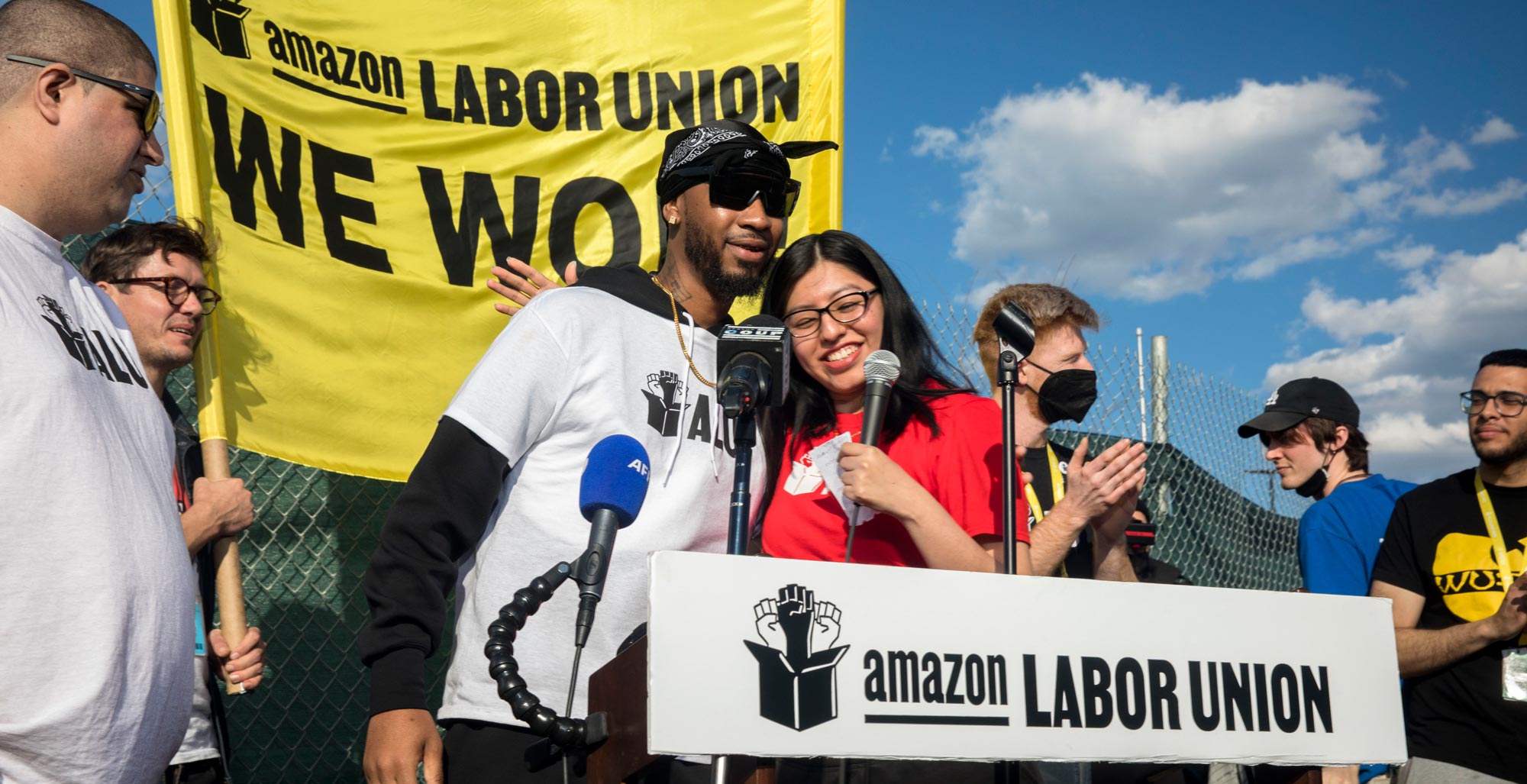
The successful organizing drive at an Amazon site in Staten Island is one of the year’s biggest stories in American labor. (Credit: Dave Sanders)
Amazon warehouse organizing, shop-by-shop Starbucks unionization efforts, strikes at John Deere and Kellogg’s in October 2021, dubbed the month Striketober, have catapulted labor organizing into the news. A spotlight on these efforts has contributed to a swell in support for unions, with more than 70% of people surveyed in a 2022 Gallup Poll approving of labor unions, the highest level since 1965. A new report by the CUNY School of Labor and Urban Studies (SLU) describes these efforts and examines new organizing in the past year and a half, from January 2021 to June 2022.
“New York in particular has a kind of leading role in some of the new organizing [in the country],” said Ruth Milkman, a distinguished professor at SLU and the Graduate Center, during a presentation at a PSC Retirees Chapter meeting in September. Milkman is a coauthor of the report, “The State of the Unions 2022: A Profile of Organized Labor in New York City, New York State and the United States.”
NEW ACTIVISM
Unionizing at media companies, Starbucks and nonprofits, Milkman noted, often have new leaders. “It’s not the usual suspects leading the charge in these campaigns. [They] are mostly young college-educated workers who are underemployed in some way.”
But Milkman isn’t celebrating yet. New organizing has not been able to make a significant dent in declining union density, a trend that has been led by an organized right-wing anti-labor assault on unions since the 1980s.
The overall numbers are still “grim,” with a “continuing relentless decline in union density,” Milkman said. Labor unions only represent 6% of private-sector workers and a third of public-sector workers nationwide. In the past two decades, union density has declined nationally, from 13.5% in 2002 to 10.2% in 2021–2022. In those nationwide numbers, New York City stands out. Union density in public and private sectors is around double the nationwide percentages. It’s also the city that has seen the most growth in new organizing.
AMAZON UPRISING
In New York City, newly organized union members in the private sector, including Staten Island Amazon workers who have organized but have not yet been officially recognized as a union, grew by 0.50%. That number may seem low, but it’s significant. New York City leads other cities in terms of union density growth, including Seattle (0.27%), Boston (0.16%), Chicago (0.11%) and Los Angeles and San Francisco (0.10%). Even without the 8,325 Amazon workers in the equation, New York City would still lead the pack at 0.29%.
That 0.50% growth translates into nearly 20,000 newly organized private-sector workers. And to put the number in even clearer perspective, it means that over the course of the 18-month study, one in five new private-sector union members in the country came from New York City.
And while the workers at the Staten Island Amazon facility represent a big chunk of those new union members, there have been significant organizing efforts in other fields, including school bus drivers, home health-care workers, journalists, security guards and nonprofit workers.
“There’s a connection between the COVID-19 pandemic and growing unionization among school bus drivers and security guards. There is a shortage of school bus drivers across the State of New York, as a result of COVID retirements, low pay and more challenging working conditions,” said Joseph van der Naald, a coauthor of the report and a PhD student in sociology at the Graduate Center. “The combination of a tight labor market (in this industry as well as more generally), low pay, and worsening job quality all contribute to growing interest in unionization.”
SHOPS ORGANIZED
Van der Naald explained to Clarion the broader context behind the report’s numbers, specifically around new organizing in New York. More than 1,600 workers became members of the Amalgamated Transit Union through organizing efforts of drivers, attendants, mechanics, dispatchers and clerical staff at major school bus companies. More than 2,500 home health-care workers joined Home Healthcare Workers of America, which is affiliated with the International Union of Journeymen and Allied Trades (IUJAT). Workers at the New York Times (591), MSNBC (322) and Insider Inc. (307) all organized. Nonprofit workers at Housing Works (604), American Museum of Natural History (205), Whitney Museum of American Art (176) and the Guggenheim Museum (144) all became union members, too.
PROMINENT CAMPAIGNS
These wins are significant and are in public-facing companies. Milkman highlights that recent college graduates are a part of this organizing, noting that they are often both interested in labor and in critiquing capitalism. PSC members who teach and work with college students can support these efforts and advocate for labor-friendly national legislation, including the PRO Act (Protecting the Right to Organize Act), that can help erode the systemic hurdles facing labor.
“Really the heavy lifting is being done by millennials and Gen Zers themselves, but anything union members in the PSC and elsewhere can do to push for passage of the PRO Act and to help build public support for the new organizing would be valuable,” Milkman said.
To read the full report, “The State of the Unions 2022: A Profile of Organized Labor in New York City, New York State and the United States,” go to tinyurl.com/state-of-the-unions-2022.
Published: September 28, 2022 | Last Modified: November 9, 2022

